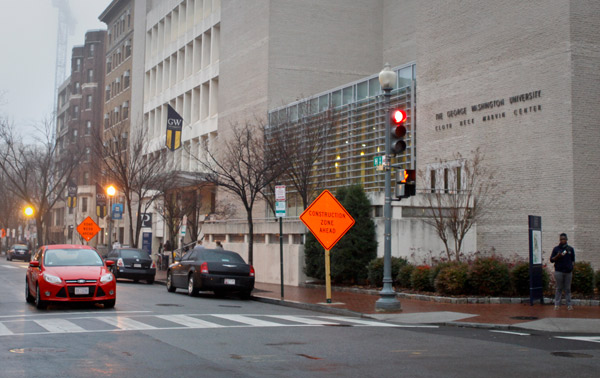Updated: Jan. 27, 2015 at 5:56 p.m.
This is the first semester that classes will be held in the brand new Science and Engineering Hall, and the last they’ll be held in 2020 K St., that long-maligned cluster of cramped underground classrooms outside of GW’s traditional campus borders.
We’re in a time of much acceleration at this University, and that’s not the only example. In the past five years alone, GW has built a museum, merged with an arts school, opened a gleaming new residence hall on the Mount Vernon Campus and constructed the District’s only public health school.
To help pay for these developments, the University is in the middle of a campaign to raise $1 billion. That sum will also go toward executing the 10-year strategic plan and refocusing GW on academics and research. We recently rebranded across the University, altering our messaging to the outside world.
GW’s on an exciting track, despite the fact that this growth may come at some cost in the immediate future.
And we have the perfect opportunity to continue on this path forward: Make the Marvin Center available for a new naming opportunity.
To put it plainly, the Marvin Center is the type of building a donor would want to put his or her name on. As our campus hub, all students must go there at significant points in their GW careers: to get their GWorld cards as brand new students, buy textbooks each semester, attend student organization meetings every week and, eventually, pick up their caps and gowns.
But many would agree there’s a far more compelling reason to rename the Marvin Center. Former University President Cloyd Heck Marvin, who served from 1927 to 1959, was a strong supporter of keeping GW segregated, arguing that students learned better in homogenized environments. He also ruled the school with what some called an “iron fist,” severely curbing academic freedom and openly criticizing student leaders.

Students protested when the building was dedicated to him in 1971 – two years after Marvin died – only to be told the man “combined vision with will, patience with tenacity” by then-President Lloyd Elliott. Though we’ve raised concerns ever since, University spokesman Kurtis Hiatt declined to comment on why the name remains the same.
As our longest-serving University president, Marvin tripled the size of the faculty, doubled enrollment and oversaw an eightfold increase in the endowment. But it’s possible to appreciate and be grateful for the positive impact he made on this school without having the name of a controversial leader emblazoned on the side of one of our most prominent buildings.
At Clemson University, students and faculty alike are calling this semester for the renaming of Tillman Hall. It bears the name of former member of the Confederate Army and “lynch law” advocate Benjamin Ryan Tillman, one of Clemson’s founders. Even one hundred years after Tillman’s death, students are actively protesting the name of this central campus building.
Similarly, it’s time that Marvin’s name is taken from its place of prominence and replaced with one that represents progress, not views that were anachronistic even in Marvin’s own time. That means a donor who is committed to GW’s success, whose contribution will directly help fund the very things that will push this University into the future: innovative research and top-ranked academics.
For example, when Ivory Tower was renamed Shenkman Hall last year, Mark and Rosalind Shenkman earmarked their $5 million donation for career services. Fundraisers could start pitching the Marvin Center to donors, luring them with the attractive possibility of having the campus hub – and starting place for prospective student tour groups – named after one of them.
It’s reasonable to wonder why this should be done now. After all, the building’s name has existed for close to half a century at this point, with just a few blips of protest along the way. It’s not offensive on its face, and Marvin’s misdeeds don’t compare to Tillman’s, for example.
And we’re not advocating for reverting the building to unnamed status – like when it was known simply as the University Center after its opening. We also understand the pitfalls of being overly politically correct. We’d never want to see every ounce of historical context erased from our 194-year-old school. But in this case, the name should be replaced with one that doesn’t pigeonhole GW into its past, but rather advances it as an institution.
There’s even precedent at the University to do this very thing: Lafayette Hall was previously called Calhoun Hall, after John C. Calhoun, a lifelong politician and vice president under both John Quincy Adams and Andrew Jackson. But students during the civil rights movement called attention to the fact that Calhoun himself was a massive pro-slavery advocate for much of his career, and the name was subsequently changed.
We have a history of activism on this campus, and that’s laudable. Although there’s no current movement to change the name of the Marvin Center, we have to respect the students who came before us who wanted it changed, the people Marvin discriminated against during his time here and any students who continue to be offended by GW’s adulation of the former president.
The editorial board is composed of Hatchet staff members and operates separately from the newsroom. This week’s piece was written by opinions editor Robin Jones Kerr and contributing opinions editor Sarah Blugis, based on discussions with managing director Justin Peligri, sports editor Nora Princiotti, copy editor Rachel Smilan-Goldstein and senior designer Anna McGarrigle.
This post was updated to reflect the following correction:
The Hatchet incorrectly reported in the timeline that Cloyd Heck Marvin had served as University president from 1927 to 1939. He served as president from 1927 to 1959. We regret this error.





